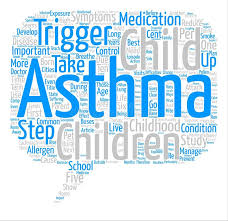hildhood Asthma can be treated and cured if Homeopathy treatment is started in time. Your child need not live with asthma pumps all their lives. They can run, play and live life on offence instead of living all life in defence.
Welling Clinic offers specially formulated Homeopathy treatment for Asthma in your child. The treatment for childhood asthma has been developed after exhaustive in-house research. Our clinics consult for more than 1200 patients of Asthma in children globally, every year. You too can be benefitted from our expertise in the treatment of Childhood Asthma.
Get Long-Standing Asthma in Children, Cured With Our Homeopathy Treatment

Despite advances in the understanding of asthma, there is still a high rate of morbidity and mortality from this disease in children. Although many factors are involved, a persistent concern is that the overuse of beta-agonists combined with the underuse of anti-inflammatory medications leads to increased mortality.
The demonstration that airway inflammation is present in mild asthma and the observations that inflammatory stimuli increase airway responsiveness have led to the use of anti-inflammatory agents at earlier stages of the disease.
Incidence of new diagnoses of asthma is associated with heavy exercise in communities with high concentrations of ozone, thus, air pollution and outdoor exercise could contribute to the development of asthma in children.
Call +91 9999064336 to book an appointment or to consult and order online. Consult our specialists today for a detailed evaluation and to start your customised Homeopathy Treatment of Childhood Asthma.
The medications with an anti-inflammatory activity that are currently available are not effective for all patients. The problems posed by chronic severe asthma in a child despite appropriate use of corticosteroids suggest that our current concepts are overly simplistic.
Asthma is typically diagnosed with a medical exam and a test that measures the airflow in and out of the lungs. Children who are of preschool age or younger may not be able to complete the airflow test, which requires blowing very hard into a tube. And since infants and toddlers can’t describe how they feel, parents, other family members and caregivers need to be alert for symptoms.
What is Childhood Asthma?
Children have smaller airways than adults, which makes asthma especially serious for them. Children with asthma may experience wheezing, coughing, chest tightness, and trouble breathing, especially early in the morning or at night. When asthma symptoms become worse than usual, it is called an asthma attack.
Symptoms of Childhood Asthma
An asthma attack is a sudden worsening of asthma symptoms caused by the tightening of muscles around your airways (bronchospasm). During the asthma attack, the lining of the airways also becomes swollen or inflamed and thicker mucus — more than normal — is produced. All of these factors — bronchospasm, inflammation, and mucus production — cause symptoms of an asthma attack such as difficulty breathing, wheezing, coughing, shortness of breath, and difficulty performing normal daily activities. Other symptoms of an asthma attack may include:
- Severe wheezing when breathing both in and out
- Coughing that won’t stop
- Very rapid breathing
- Chest tightness or pressure
- Tightened neck and chest muscles, called retractions
- Difficulty talking
- Feelings of anxiety or panic
- Pale, sweaty face
- Blue lips or finger nails
- Or worsening symptoms despite use of your medications
Mild asthma attacks are generally more common. Usually, the airways open up within a few minutes to a few hours after treatment. Severe asthma attacks are less common but last longer and require immediate medical help. It is important to recognize and treat even mild symptoms of an asthma attack to help you prevent severe episodes and keep asthma under control.
Causes of Childhood Asthma
Many things can cause asthma, including
- Allergens – mold, pollen, animals
- Irritants – cigarette smoke, air pollution
- Weather – cold air, changes in weather
- Exercise
- Infections – flu, common cold
Prevention of Childhood Asthma
Asthma is different from one person to another. Some people will immediately respond to the asthma action plan; hence, preventing the need of a doctor. Avoiding asthma triggers is one of the best ways of controlling asthma. Consult with your doctor and identify high-risk factors that can trigger an asthma attack. Such triggers include things like dust, pollen, pets, allergens, and chemical fumes; however, one trigger that individuals should not avoid is physical exercise. Instead, perform light exercises when the weather is good.
Diagnosis of Childhood Asthma
Pulmonary function tests (PFTs) are used to test lung performance, but in children younger than 5 years, the results are typically not reliable.
- An asthma specialist, such as a pulmonologist or allergist, can perform breathing tests using a spirometer, a machine that measures the amount of air that flows in and out of the lungs. It can detect blockage if the airflow is lower than normal, and it can also detect if the airway obstruction is involving only small airways or larger airways too.
- The doctor may take a spirometer reading, give the child an inhaled medication that opens the airways (bronchodilator therapy), and then take another reading to see if breathing improves with medication. If medication reverses airway obstruction (blockage), as indicated by improved airflow, then there’s a strong possibility that the child has asthma. A peak flow meter is a simple device used to measure the peak flow of air coming out of the lungs when a child is asked to blow air into it.
- The peak flow meter readings are different than spirometer readings. However, a child can have a normal peak airflow and still have airway obstruction that is detected with spirometry. The peak flow can have a normal value while the values for other parameters, such as forced expiratory volume in 1 second (FEV1) or forced expiratory flow during mid-portion of forced vital capacity (FEF25-75), are reduced suggesting airway obstruction. Thus, spirometry is more informative compared to only peak flow meter readings.
- Moreover, since the peak flow meter is effort dependent, the readings obtained may vary, depending upon the patients’ effort and may be misleading.
- Another test is called plethysmography. This test measures lung capacity and lung volumes (the amount of air the lung can hold). Patients with chronic persistent asthma may have lungs that are over-inflated; over-inflation is diagnosed when a patient has increased lung capacity detected by this test.
- Patients with a history of exercise-induced symptoms (eg, cough, wheeze, chest tightness, pain) can undergo an exercise challenge test. This test is usually done in children older than 6 years. The baseline (or usual) lung function for the child is measured (using spirometry) while the child is sitting still. Then the child exercises, usually by riding a stationary bicycle or walking fast on a treadmill.
- When the child’s heart is beating faster from the exercise, the lung function is measured again. Measurements are taken immediately after the exercise and at 3, 5, 10, 15, 20 minutes after the first measurement and after a dose of inhaled bronchodilator. This test detects decreased lung function caused by exercise.
- chest x-ray(radiograph) if the asthma isn’t helped by the usual treatments.
- Allergy testing can be used to identify factors your child is allergic to because these factors might contribute to asthma. Once identified, environmental factors (eg, dust mites, cockroaches, molds, animal dander) and outdoor factors (eg, pollen, grass, trees, molds) may be controlled or avoided to reduce asthma symptoms.
Treatment of Childhood Asthma
The most important part of managing asthma is for child to be very knowledgeable about how and when asthma causes problems, how some of the triggers can be avoided and how to use medications. The causes of asthma and best treatment for one child may be quite different than for another child.
The allergist will help you develop an asthma management plan, and it is wise to share it with other caregivers. This plan outlines what medications to take, and when and how to increase the doses or add more medication if needed. It also includes advice about when to call your physician. An asthma management plan puts you in control for detection and early treatment of symptoms.
Inhaled medications come as metered-dose inhalers (sometimes called pumps), nebulizer solutions (delivered as a mist by a machine) and dry powder inhalers. It is important to learn how to use the type of medications prescribed for the child, or they might not work well.
Asthma medications include inhaled rescue medications (quick-relievers) to treat symptoms and long-term controller medicines (inhaled as well as oral) to control inflammation that commonly causes the asthma. If the child’s asthma is more than a rare minor problem, a controller medication will probably be prescribed.
Homeopathy Treatment of Childhood Asthma
Homeopathy is a system of medicine that tries to ‘cure’ this disease, instead of trying to provide symptomatic relief. Conventional drugs used for treating asthma, particularly steroids, can impair immune function and lead to more serious health problems. Homeopathic constitutional care is necessary to achieve a lasting cure of asthma, while the following remedies can often be helpful in reducing the distress that an acute attack can create.








